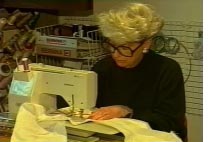|
Thoughts from the Artist
The creative process is an interesting procedure, certainly different for every person
and most often different for every project. For me it usually begins with in depth conversations with my client (an individual or group), be it in person or via the telephone. This discussion procedure
is invaluable for it is at this level I hear the intent of the assignment, and more importantly I begin the exploration of the full project.
My next step is reading and researching the subject
matter at hand which often embraces the object I am creating or covering and the thematic design I am using for the artwork. If, for example the project is a Torah Mantle with a proposed biblical theme,
I begin with The Torah A Modern Commentary and the Hertz Chumash (both books contain text and editorial comments of the Old Testament). I then progress to a multitude of sources including some on
the world wide web, all dealing with various aspects of the topic. If it is a wedding canopy, or a prayer shawl I may begin with another source and proceed on from there.
My legal pad fills with notes. I synthesize my findings with the aid of my word processor and as I do visual images begin to
take shape. I sketch my interpretations of the concepts that seem to occupy my thoughts: abstractions, cognitive speculations, storylines, feelings, and more.
Color, fabric and texture choices now become important at this juncture in the endeavor. With my sketches in hand I peruse my
vast *stash of fabrics, threads, and embellishments and make some preliminary choices. I unfold the silk, linen, or perhaps the velvet, and I begin to visualize my design ideas.
The method of implementation begins to take focus, whether it be stitchery, applique, or some other artistic media. More questions surface: should I include words, photographic imagery, etc.?
Magic and serendipity are extremely important elements in this whole process. When the needle first pierces the fabric a new
atmosphere pervades. Changes take place; the juxtaposition of the design and the materials begins to take on a life of its own. Other design elements begin to speak calling for another
method or feature, perhaps. Chance and unpredictable stitchery movements make exciting inclusions.
The sewing process itself becomes a meditative time for contemplations when new imagery surfaces and new discoveries are
made. The decision for the surface to be encrusted with a variety of stitches and a myriad of embellishments could change with the realization that the
message of the subject would impact more with a more pristine and quiet surface.
When the artwork is completed and the task appears to be achieved there always seems to be a need to add a few extra
decorative stitches, a tassel, or an extra flourish, or even possibly delete a spangle or two.
The artworks I make are the product of my hands, my intellect, and my soul. I find this whole creative process exciting and
stimulating and hope that my artistic efforts impart these feelings
*Stash: Most fiber artists have an irresistible compulsion for
collecting massive amounts of fabric or embellishments that somehow speak to them. Their instincts take them to places where they can support this addiction so they can accumulate,
stockpile, treasure, cache, squirrel away ( or what ever words you want to use) that very object or remnant that grabs their emotion at the time. A few years ago I saw a tee shirt in a
textile and button catalogue with the slogan, " The one who dies with the most fabric wins."
|

